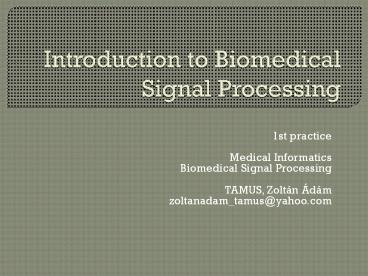Introduction to Biomedical Signal Processing - PowerPoint PPT Presentation
Title:
Introduction to Biomedical Signal Processing
Description:
1st practice Medical Informatics Biomedical Signal Processing TAMUS, Zolt n d m zoltanadam_tamus_at_yahoo.com The living organism made up of many component system ... – PowerPoint PPT presentation
Number of Views:3909
Avg rating:3.0/5.0
Title: Introduction to Biomedical Signal Processing
1
Introduction to Biomedical Signal Processing
- 1st practice
- Medical InformaticsBiomedical Signal Processing
- TAMUS, Zoltán Ádám
- zoltanadam_tamus_at_yahoo.com
2
The Nature of Biomedical Signals
- The living organism made up of many component
system and each system is made up of several
subsystems that carry on many physiological
processes. - Most physiological processes are accompanied by
or manifest themselves as signals that reflect
their nature and activities. - Signals biochemical, electrical, physical
3
The Nature of Biomedical Signals
- Diseases or defects in a biological system cause
alteration its normal physiological processes,
leading to pathological processes. - A pathological process is typicaaly associated
with signals that are different in some respects
from the corresponding normal signals.
4
Sensing of Biological Signals
- The signals can be sensed by qualitative or
quantitative manner. - Measurement
- Scalar
- Function of time
- discrete xn
- continuous x(f)
- digital
- Multivariant vector
5
Objectives of Biomedical Signal Analysis
- Information gathering
- measurement of phenomena to interpret a system
- Diagnosis
- detection of malfunction, pathology, or
abnormality - Monitoring
- obtaining continuous or periodic information
about a system
6
Objectives of Biomedical Signal Analysis
- Therapy and control
- Modification of the behaviour of system based
upon the outcome of the activities listed above
to ensure a specific result - Evaluation
- Objective analysis to determinate the ability to
meet functional requirements, obtain a proof of
performance, perform quality control, or qualify
the effect of treatment
7
Signal Acqusition Procedures
- Invasive
- placement of transducers or other devices inside
the body - Noninvasive
- minimize risk
- surface electrodes
- Active
- require external stimuli
- Passive
- not require external stimuli
8
The Components of Human-Instrument System
- The subject or patient
- Stimulus or procedure of activity
- Transducers
- electrodes, sensors
- Signal-conditioning equipment
- amplifier, filter
- Display equipment
- oscilloscopes, strip charts, computer monitors
etc.
9
The Components of Human-Instrument System
- Recording, data processing, and transmission
equipment - Analog instrumentation tape recorders,
analog-to-digital converters (ADCs),
digital-to-analog converters (DACs), digital
tapes, CDs, computers, telemetry systems etc. - Control devices
- Power supply, isolation equipment, patient
intervention systems
10
Properties of Biomedical Instruments
- Isolation of the subject or patient
- Range of operation
- The minimum to maximum values of the signal being
measured. - Sensitivity
- the smallest signal variation measurable
(resolution) - Linearity
- Hysteresis
- a lag in measurement due to the direction of
variation of the entity being measured.
11
Properties of Biomedical Instruments
- Frequency response
- represents of the variation of the sensitivity
with frequency - Stability
- an unstable system could preclude repeatability
and consistency of measurements - Signal to noise Ratio (SNR)
- noises could compromise the quality of the signal
being acquired. - Accuracy
12
Difficulties of Biomedical Signal Processing
- Accessibility of the variables to measurement
- Variability of the signal source
- Inter-relationship and interactions among
physiological systems - Effect of the instrumentation or procedure on the
system - Physiological artifacts and interference
- Energy limitation
- Patient safety
13
Computer Aided Diagnosis and Therapy
Signal data acquisition
Patient
Amplifiers filters
A/D conversion
Transducers
Isolation
CAD T
Pattern recognition, classification, diagnosis
decision
Analysis of events of waves feature extraction
Filtering to remove artifacts
Detection of events components
Physician
Signal analysis
Signal processing
14
Why the CAD Systems are Used?
- Humans are highy skilled and fast in analysis of
visual patterns and waveforms, but are slow in
arithmetic operations with large numbers of
values. - Humans could be affected by fatigue, boredom and
enviromental factors. Computers are inanimate but
mathematically accurate and consistent machines
can be designed to perform repetitive tasks.
15
Why the CAD Systems are Used?
- Analysis by humans is usually subjective and
qualitative. - Analysis by humans is subject inter-observers and
intra-observers variation with time. - The biomedical signals are fairly slow therefore
these can be analised on-line by low-end
computers. - Off-line analysis by the stored data.
16
Reference
- Rangaraj M. Rangayyan Biomedical Signal
Analysis, IEEE Press/Wiley, New York, NY, 2002.































